Market Update December 2023
The Wholesale Electricity Market
Spot prices in the wholesale electricity market increased through December. Average spot prices ranged from $169 in the lower South Island (up from $127 in November), up to $184 in the upper North Island (up from $154).
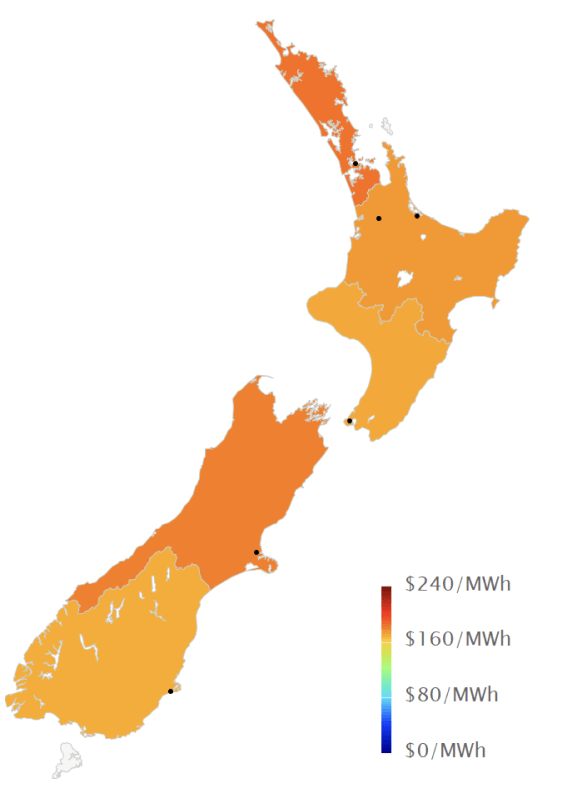
The following chart shows average weekly spot prices over the last 2 years. The recent increase in prices can be clearly seen to the right of the graph.

Electricity Demand
Electricity demand in December was on a par with recent years, falling as we head into the warmer summer period.

Electricity Generation Mix
Attempts to conserve hydro storage led to increased thermal generation through December as shown below, though reduced demand means this remains well below winter levels.

HVDC Transfer
Power transfers on the HVDC link connecting the North and South Islands are important both in showing relative hydro positions and the reliance on thermal power to meet demand. High northward flow tends to indicate a good SI hydro position, whereas the reverse indicates a heavy reliance on thermal power to make up for hydro shortages.
December saw northward transfer reduce to conserve SI hydro storage. Later in the month there was even some significant southward transfer.

The Electricity Futures Market
The Futures Market provides an indication of where market participants see the spot market moving in the future. They are based on actual trades between participants looking to hedge their positions (as both buyers and sellers) into the future against potential spot market volatility. They are also a useful proxy for the direction of retail contracts.
The following graph shows Futures pricing for CY 2024, 2025, 2026 and 2027 at Otahuhu (Auckland) for the last 2 years.

Note that $100/MWh equates to 10c/kWh.
Forward prices were up in December for all future years. CY 2024 closed at $185/MWh (+8%), while CY 2025 was at $163 (+2%). CY 2026 price was up 5% at $152 and CY 2027 closed at $139/MWh (+2%).
Known new generation projects are shown below (additions / removals highlighted in bold).
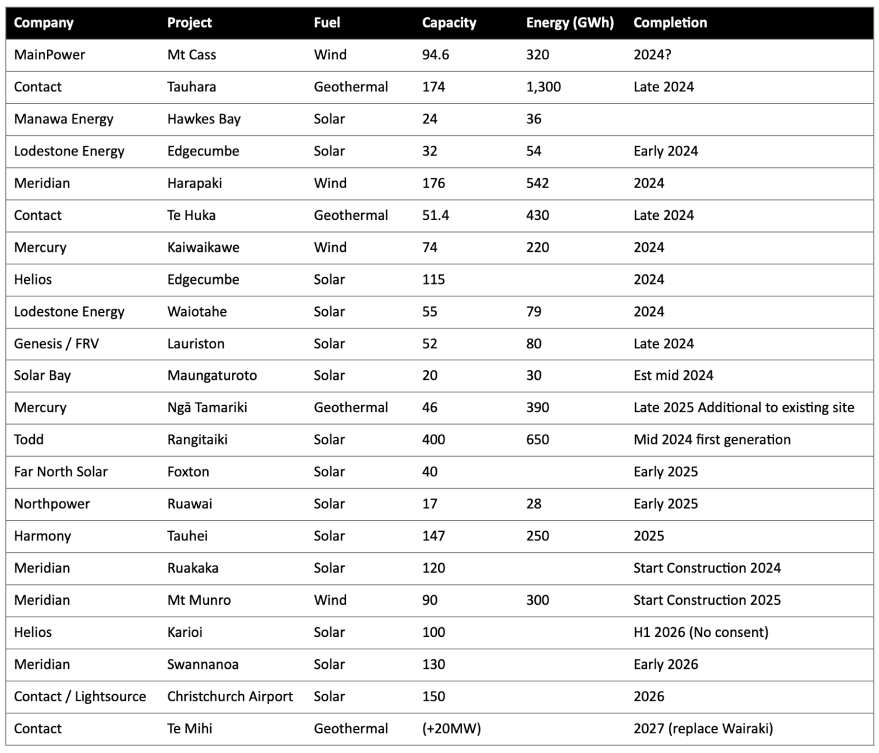
Hydro Storage
Inflows were below average in both the North and South Island through December as shown in the following charts. Inflows did increase towards the end of the month (not shown in the charts).

Below average December inflows resulted in energy storage levels in New Zealand’s main hydro storage lakes decreasing through the month, though there was an uplift due to increased inflows at the end of the month. Storage ended the month at 3,000GWh or 68% full, up 162GWh. The following chart shows the latest breakdown of storage across the main hydro catchments.

Security of supply risks decreased in December with storage levels increasing. We remain slightly below the level we would typically expect to see for this time of year; but remain well above the risk zones. This is shown in the following risk curves.

Snow Pack
Snowpack is an important way that hydro energy is stored over the winter months and released as hydro inflows in the spring. The following graph shows that the snowpack in the important Waitaki catchment is currently below mean levels seen in the last 30 years for this time of year.

Climate outlook overview (from the MetService)
Climate Drivers — El Nino conditions remain in place through the equatorial Pacific, peaking this month. However, despite these oceanic conditions, weather across New Zealand may end up quite different to what we usually regard as typical El Nino conditions as other shorter term climate drivers dictate. One of these is the Madden-Julian Oscillation (MJO) which may become active again over the tropics north of New Zealand towards the latter parts of the month. This may help drive an unsettled Tasman Sea which brings the risk of rain to northern and western parts of the country. However, this progression of the MJO is not set in stone, and a longer, more typical El Nino dry period should be seen through to the middle of January at least.
January 2023 Outlook — The month of January may very well end up with two distinct periods. A large and slow-moving high pressure system is likely to dominate over New Zealand through to about mid-month. This generally means sunnier days, pleasant temperatures and lighter winds. There may be the odd front here and there, but overall, these should not result in much severe weather. That said, they could increase temperatures and humidity, and in turn create conditions favourable to showers and potential thunderstorms for some inland places. These should be somewhat isolated and as a result, soil moisture deficits could increase quickly over the next week or two for most places. There are signs of these settled conditions departing during the last two weeks of the month as Tasman Sea systems may become more common again. This will be very dependent on the high that needs to give way first, and this battle between the high and an incoming Tasman Sea system can be tricky to pin down this far in advance. However, there are hints of north to northwesterly rain for northern and western parts of the country, potentially flipping a dry month to normal or slightly wetter than normal for some there. Confidence decreases for the South Island where places like Canterbury and West Coast lies borderline with incoming rain, while it may run drier in the deep south. Temperatures and humidity should increase next week, making for some unpleasant nights in particular. Humidity is likely to remain a factor later in the month for northern parts of the country, while southern regions could see a cooler period or two.
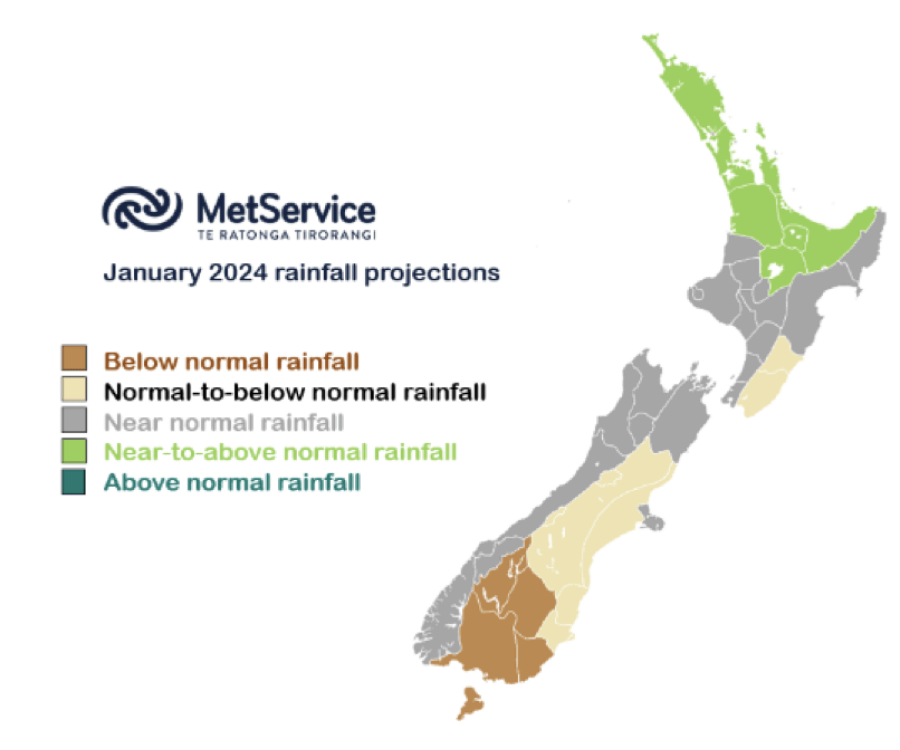
The Wholesale Gas Market
Spot gas prices increased again in December averaging $14.5/GJ – up 8% in the month. Wholesale prices are now about 38% higher than they were at the same time last year.
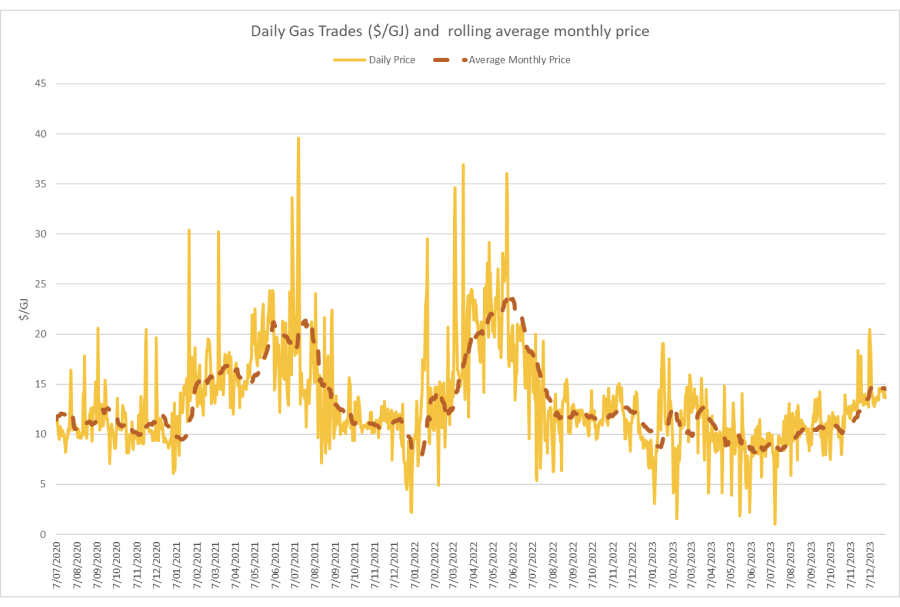
On the supply side Kupe resumed production at the end of the first week of December – averaging close to 50TJ per day when it returned from an extended outage. Maui output was flat – averaging about 93TJ/day. Pohokura had declining output, averaging 63TJ/day, as was McKee / Mangahewa, down slightly at around 69TJ/day in December.
The following graph shows production levels from major fields over the last 4 years.
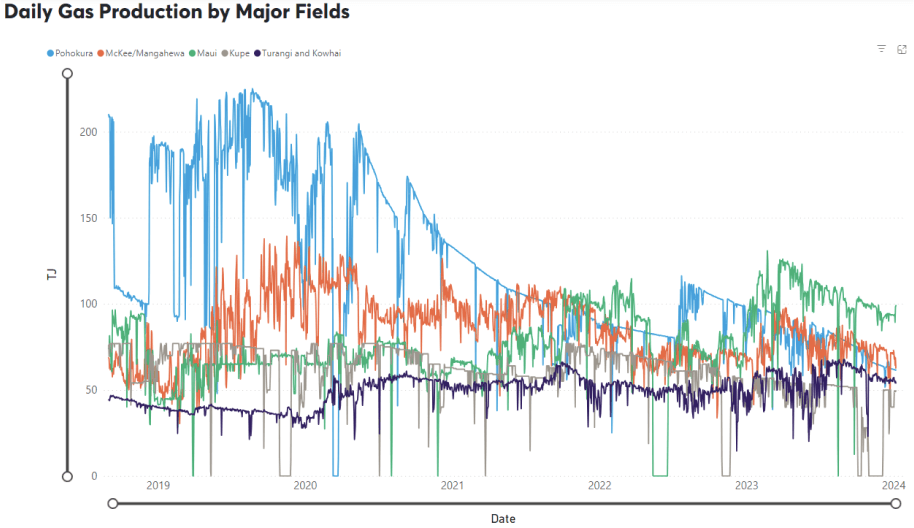
On the demand side, Methanex Motonui’s usage increased in December to around 150TJ/day for most of the month. Huntly power station gas use increased during the month, averaging 44TJ/day, while TCC started up in the middle of the month, averaging around 30TJ per day once operating.
The following graph shows trends in the major gas users over the last 4 years.
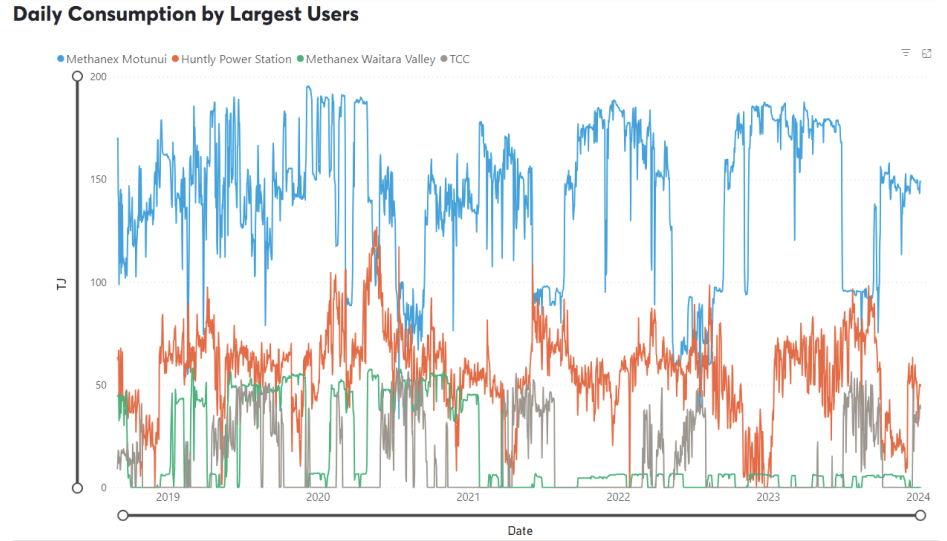
Internationally, LNG netback prices ended the month at $19/GJ – down 13% from last month. Forecast prices for 2024 fell sharply to $14.7 – down 21% compared to November. Forecast prices for 2025 were also shown for the first time – $15/GJ.

New Zealand does not have an LNG export market, so our domestic prices are not directly linked to global prices. However, some of our large gas users deal in international markets which are impacted by global gas prices, and they may try to produce more in NZ (increase demand) to take advantage of lower gas prices.
LNG is an important fuel for many large energy users, particularly in areas where reticulated natural gas is not available. The contract price of LNG is typically set by international benchmarks such as the Saudi Aramco LPG – normally quoted in US$ per metric tonne.
The following graph shows the Saudi Aramco LPG pricing for the last 3 years as well as forecast pricing for the year ahead.

The other main contributing factor to LPG prices in New Zealand is the exchange rate against the USD. As shown below this has been falling over the last few years adding to domestic LPG prices.
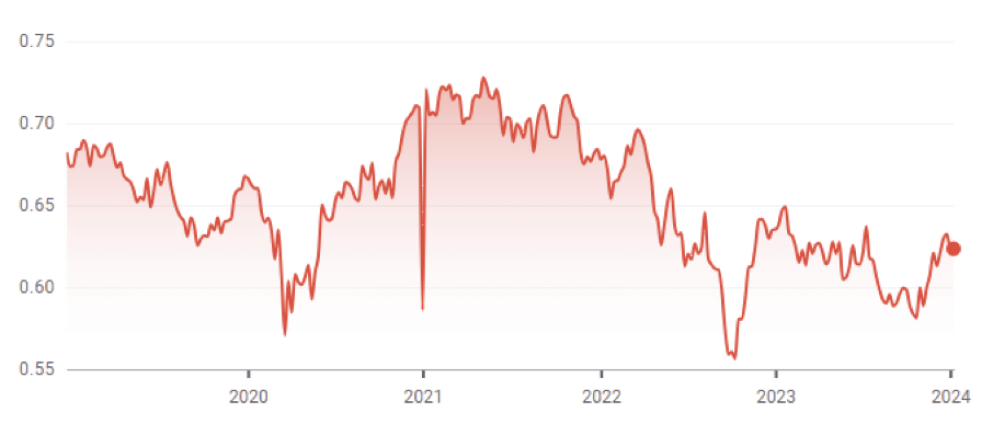
The Coal Market
The global energy crisis has been as much about coal as it has gas. The war in the Ukraine has driven energy prices, including coal, up. Prices in December increased, ending the month at US$148/T – an 11% increase on the November close. These prices, though well below the highs of the last 12 months, remain above what we expect to see as shown in the following graph of prices over the last 10 years.

Like gas, the price of coal can flow through and have an impact on the electricity market. However, coal stockpiles at Huntly are at the highest they have been for many years helping to assure the market that there is plenty of fuel available in the event of dry conditions in the hydro catchments.
Carbon Pricing
NZ has had an Emissions Trading Scheme (ETS) in place since 2008. It has been subsequently reviewed by several governments and is now an “uncapped” price scheme closely linked to international schemes. However, there are “upper and lower guard-rails” set up to prevent wild swings in carbon price that act as minimum and maximum prices. These increased in December 2023 to $173 and $64 respectively. Carbon prices fell 10% in December to $68.5.
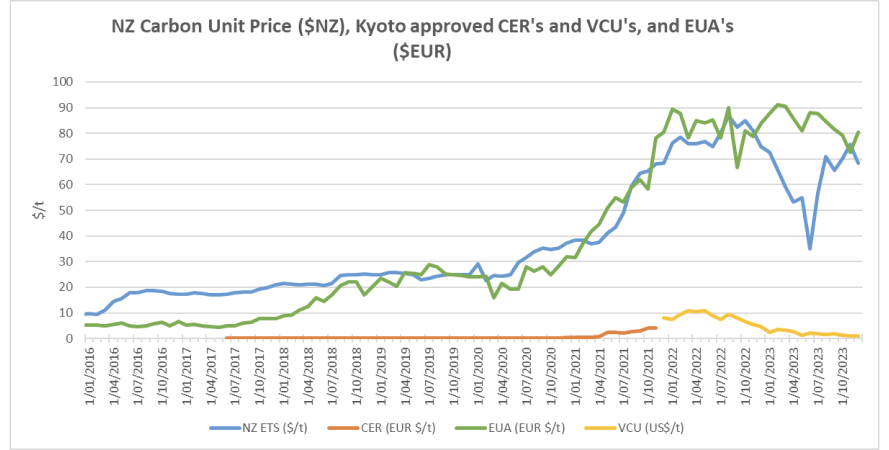
As the carbon price rises, the cost of coal, gas or other fossil fuels used in process heat applications will naturally also rise. Electricity prices are also affected by a rising carbon price. Electricity prices are set by the marginal producing unit – in NZ this is currently typically coal or gas or hydro generators, with the latter valuing the cost of its water against the former. An increase in carbon price can lead to an increase in electricity prices in the short to medium term (as the marginal units set the price). A carbon price of $50/t is estimated to currently add about $25/MWh (or ~2.5c/kWh) to electricity prices. In the long term the impact should reduce as money is invested in more low-cost renewables and there is less reliance on gas and coal fired generation.
EU Carbon Permits increased in December to 80 Euro/tonne – up 11%.
About this Report
This energy market summary report provides information on wholesale price trends within the NZ Electricity Market.
Please note that all electricity prices are presented as a $ per MWh price and all carbon prices as a $ per unit price.
All spot prices are published by the Electricity Authority. Futures contract prices are sourced from ASX.
Further information can be found at the locations noted below.
- Transpower publishes a range of detailed information which can be found here: https://www.transpower.co.nz/power-system-live-data
- The Electricity Authority publishes a range of detailed information which can be found here: https://www.emi.ea.govt.nz/
- Weather and Climate data – The MetService publishes a range of weather-related information which can be found here: https://www.metservice.com/
Disclaimer
This document has been prepared for information and explanatory purposes only and is not intended to be relied upon by any person. This document does not form part of any existing or future contract or agreement between us. We make no representation, assurance, or guarantee as to the accuracy of the information provided. To the maximum extent permitted by law, none of Smart Power Ltd, its related companies, directors, employees or agents accepts any liability for any loss arising from the use of this document or its contents or otherwise arising out or, or in connection with it. You must not provide this document or any information contained in it to any third party without our prior consent.
About Smart Power
Smart Power is a full-service Energy Management consultancy. Apart from Energy Procurement, Smart Power can also provide:
- Technical Advice on how to reduce your energy use/emissions
- Sustainability Reporting
- Invoice Management services.
We also offer boutique energy and water billing service for landlords/property developers.
Contact us at https://smartpower1.wpenginepowered.com/contact/ or ring one of our offices to talk to one of our experienced staff about how we can assist you with achieving your energy goals.
© Copyright, 2024. Smart Power Ltd